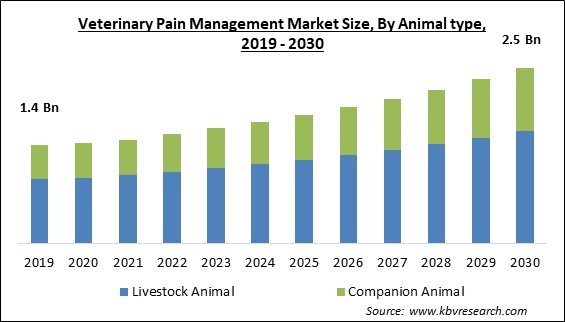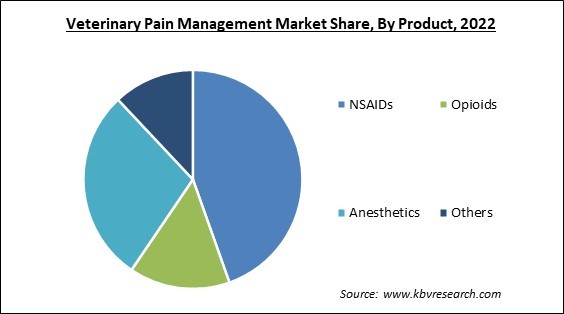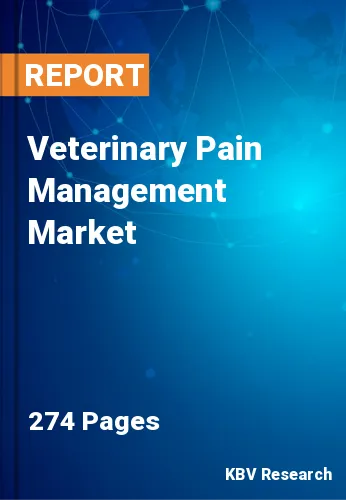The Global Veterinary Pain Management Market size is expected to reach $2.5 billion by 2030, rising at a market growth of 6.2% CAGR during the forecast period.
Obesity is the primary cause of joint issues in dogs, and it can also contribute to other orthopedic problems like hip dysplasia and arthritis pain. Thus, the Companion segment will register a 2/5th share of the market by 2030. Due to the additional pressure on bones, obesity in pet companions can cause various diseases of the bones and joints. In fatty and overweight animals, arthritis and ligament rips are prevalent and more severe. Compared to adult dogs, puppies are quite more prone to fractures. Additionally, the owner's capacity to spend on their pet's orthopedic operation and growing pet care awareness are fostering the market's expansion. Some of the factors impacting the market are increasing public concern for animal health and welfare, humanization trend and rising pet ownership, and legal issues in pain management.

The demand for these products has increased as a result of the increasing efforts taken by various governments in different areas. In the UK, pertinent cattle health and welfare issues tend to be resolved through the Cow Health and Welfare Group (CHAWG). The CHAWG is the first contact for inquiries relating to the welfare, health, and disease concerns currently impacting cattle. The makeup of CHAWG was a highly beneficial resource for the market because it offered a broad and in-depth range of information about cattle health and welfare. Therefore, this market is being driven by a rising number of initiatives undertaken by major businesses and government agencies. Globally, pet ownership is on the rise, especially in millennial households, inclined to be smaller families with children raised later in life. Pet lovers benefit the business and are anticipated to significantly contribute to market expansion during the forecast period. Many businesses are striving to provide superior pet care products in response to the rising demand for luxury pet products worldwide to acquire a significant share of the market. Given these factors, it is projected that as pet ownership and the humanization phenomenon increase, this will impact the market.
However, there are several ethical and practical issues in treating farm animals' pain. The conflicting needs of society as a whole and animals are apparent in a legal sense. Legislative frameworks for the administration of analgesic drugs to these animals need to consider various factors, such as the risk of abuse if powerful controlled analgesic drugs, like narcotics, are not properly stored and accounted for. Thus, the legal issues surrounding pain management could have a negative effect on the market's expansion in the coming years.
Based on product, the market is segmented into NSAIDs, anesthetics, opioids, and others. In 2022, the NSAIDs segment dominated the market with the maximum revenue share. This is due to the increased use of nonsteroidal anti-inflammatory drugs (NSAIDs) for animal analgesics. NSAIDs are widely used to relieve pain and inflammation in animals with osteoarthritis. The major market players are also creating brand-new NSAIDs to reduce the reactions and negative effects brought on by existing ones. Animal owners are under increasing pressure to adhere to the prevailing veterinarian health standards to meet consumer demand for dairy products, fresh meat, and dietary supplements generated from animals. The use of veterinary NSAIDs is anticipated to increase in the coming years.

By animal type, the market is classified into livestock animal and companion animal. The companion animal covered a considerable revenue share in the market in 2022. Their increased ownership, awareness, and need for effective animal care are responsible for the growth of the segment. Additionally, the incidence of obesity and other chronic diseases like cancer and osteoarthritis is rising, fueling the market.
Based on end-use, the market is categorized into hospitals & clinics and others. In 2022, the hospitals and clinics segment witnessed the largest revenue share in the market. It is due to these verticals provide a wide range of diagnostic and treatment options. The need for outpatient facilities and increased surgical procedures are major growth drivers propelling the segment's expansion. Additionally, veterinary hospitals have modern technology.
On the basis of indication, the market is fragmented into osteoarthritis, post-operative pain, and others. The post-operative pain recorded a remarkable revenue share in the market in 2022. The growing number of veterinary surgeries in both developed and developing markets can be attributed to the significant proportion of this segment. The demand for veterinary surgery is driven by an increase in the prevalence of periodontal disease in pets and a need for better treatment alternatives. Most animals experience pain after surgery, prompting the use of veterinary pain management products.
| Report Attribute | Details |
|---|---|
| Market size value in 2022 | USD 1.6 Billion |
| Market size forecast in 2030 | USD 2.5 Billion |
| Base Year | 2022 |
| Historical Period | 2019 to 2021 |
| Forecast Period | 2023 to 2030 |
| Revenue Growth Rate | CAGR of 6.2% from 2023 to 2030 |
| Number of Pages | 274 |
| Number of Table | 431 |
| Report coverage | Market Trends, Revenue Estimation and Forecast, Segmentation Analysis, Regional and Country Breakdown, Companies Strategic Developments, Company Profiling |
| Segments covered | Animal type, Indication, Product, End-use, Region |
| Country scope | US, Canada, Mexico, Germany, UK, France, Russia, Spain, Italy, China, Japan, India, South Korea, Singapore, Malaysia, Brazil, Argentina, UAE, Saudi Arabia, South Africa, Nigeria |
| Growth Drivers |
|
| Restraints |
|
Region-wise, the market is analysed across North America, Europe, Asia Pacific, and LAMEA. In 2022, the North America region generated the highest revenue share in the market. This is due to an increase in pet ownership and the need for superior animal care. Well-established and cutting-edge animal healthcare facilities are also supporting the growth. The requirement for veterinary prescriptions in North America is anticipated to increase prescription drug sales during the forecasted period in this region.
The market research report covers the analysis of key stakeholders of the market. Key companies profiled in the report include Boehringer Ingelheim International GmbH, Bayer AG, Zoetis, Inc., Merck & Co., Inc., Elanco Animal Health, Inc., Zomedica Corp. (Assisi Animal Health), Norbrook Laboratories Limited, Ceva Santé Animale, Dechra Pharmaceuticals PLC, and Vetoquinol SA (Soparfin SCA)
Free Valuable Insights: Global Veterinary Pain Management Market size to reach USD 2.5 Billion by 2030
By Animal type
By End-Use
By Indication
By Product
By Geography
The Market size is projected to reach USD 2.5 billion by 2030.
Humanization trend and rising pet ownership are driving the Market in coming years, however, Legal issues in pain management restraints the growth of the Market.
Boehringer Ingelheim International GmbH, Bayer AG, Zoetis, Inc., Merck & Co., Inc., Elanco Animal Health, Inc., Zomedica Corp. (Assisi Animal Health), Norbrook Laboratories Limited, Ceva Santé Animale, Dechra Pharmaceuticals PLC, and Vetoquinol SA (Soparfin SCA)
The Osteoarthritis segment acquired maximum revenue share in the Market by Indication in 2022; thereby, achieving a market value of $1.5 billion by 2030.
The Livestock Animal segment is leading the Market by Animal type in 2022; thereby, achieving a market value of $1.6 billion by 2030.
The North America region dominated the Market by Region in 2022, and would continue to be a dominant market till 2030; thereby, achieving a market value of $872.3 million by 2030.
Our team of dedicated experts can provide you with attractive expansion opportunities for your business.

